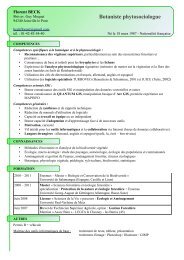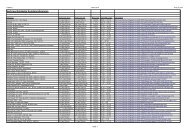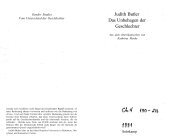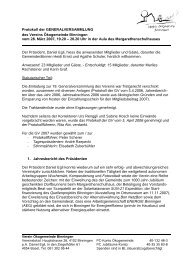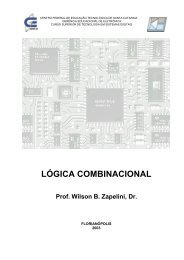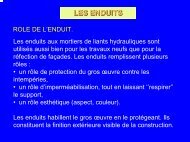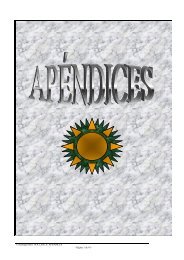479 Horizontal Motion: The horizontal component of velocity ... - Wuala
479 Horizontal Motion: The horizontal component of velocity ... - Wuala
479 Horizontal Motion: The horizontal component of velocity ... - Wuala
You also want an ePaper? Increase the reach of your titles
YUMPU automatically turns print PDFs into web optimized ePapers that Google loves.
91962_05_R1_p0<strong>479</strong>-0512 6/5/09 3:53 PM Page <strong>479</strong><br />
© 2010 Pearson Education, Inc., Upper Saddle River, NJ. All rights reserved. This material is protected under all copyright laws as they currently<br />
exist. No portion <strong>of</strong> this material may be reproduced, in any form or by any means, without permission in writing from the publisher.<br />
R1–1. <strong>The</strong> ball is thrown <strong>horizontal</strong>ly with a speed <strong>of</strong><br />
8 m>s. Find the equation <strong>of</strong> the path, y = f(x), and then<br />
determine the ball’s <strong>velocity</strong> and the normal and tangential<br />
<strong>component</strong>s <strong>of</strong> acceleration when t = 0.25 s.<br />
y<br />
v A 8 m/s<br />
A<br />
x<br />
<strong>Horizontal</strong> <strong>Motion</strong>: <strong>The</strong> <strong>horizontal</strong> <strong>component</strong> <strong>of</strong> <strong>velocity</strong> is y x = 8 m>s and the<br />
initial <strong>horizontal</strong> position is (s 0 ) x = 0.<br />
A : + B s x = (s 0 ) x + (y 0) x t<br />
x = 0 + 8t<br />
[1]<br />
Vertical <strong>Motion</strong>: <strong>The</strong> vertical <strong>component</strong> <strong>of</strong> initial <strong>velocity</strong> (y 0) y = 0 and the initial<br />
vertical position are (s 0) y = 0.<br />
( + c) s y = (s 0 ) y + (y 0 ) y t + 1 2 (a c) y t 2<br />
y = 0 + 0 + 1 ( -9.81) t2<br />
2<br />
[2]<br />
Eliminate t from Eqs. [1] and [2] yields<br />
y = -0.0766x 2<br />
Ans.<br />
<strong>The</strong> vertical <strong>component</strong> <strong>of</strong> <strong>velocity</strong> when t = 0.25 s is given by<br />
(+ c) y y = (y 0) y + (a c ) y t<br />
y y = 0 + (-9.81)(0.25) = -2.4525 m>s = 2.4525 m>s T<br />
<strong>The</strong> magnitude and direction angle when t = 0.25 s are<br />
y = 2y 2 x + y 2 y = 28 2 + 2.4525 2 = 8.37 m>s<br />
u = tan y - 1 y<br />
= tan - 1 2.4525 = 17.04° = 17.0° c<br />
y x 8<br />
Ans.<br />
Ans.<br />
Since the <strong>velocity</strong> is always directed along the tangent <strong>of</strong> the path and the<br />
acceleration a = 9.81 m>s 2 is directed downward, then tangential and normal<br />
<strong>component</strong>s <strong>of</strong> acceleration are<br />
a t = 9.81 sin 17.04° = 2.88 m>s 2<br />
a n = 9.81 cos 17.04° = 9.38 m>s 2<br />
Ans.<br />
Ans.<br />
<strong>479</strong>
91962_05_R1_p0<strong>479</strong>-0512 6/5/09 3:53 PM Page 480<br />
© 2010 Pearson Education, Inc., Upper Saddle River, NJ. All rights reserved. This material is protected under all copyright laws as they currently<br />
exist. No portion <strong>of</strong> this material may be reproduced, in any form or by any means, without permission in writing from the publisher.<br />
R1–2. Cartons having a mass <strong>of</strong> 5 kg are required to move<br />
along the assembly line with a constant speed <strong>of</strong> 8 m>s.<br />
Determine the smallest radius <strong>of</strong> curvature, r, for the<br />
conveyor so the cartons do not slip.<strong>The</strong> coefficients <strong>of</strong> static<br />
and kinetic friction between a carton and the conveyor are<br />
m s = 0.7 and m k = 0.5, respectively.<br />
8 m/s<br />
r<br />
+ c ©F b = m a b ; N - W = 0<br />
N = W<br />
F s = 0.7W<br />
: + ©F n = m a n ; 0.7W = W<br />
9.81 a 82<br />
r b<br />
r = 9.32 m<br />
Ans.<br />
R1–3. A small metal particle travels downward through a<br />
fluid medium while being subjected to the attraction <strong>of</strong> a<br />
magnetic field such that its position is s = (15t 3 - 3t) mm,<br />
where t is in seconds. Determine (a) the particle’s<br />
displacement from t = 2 s to t = 4 s, and (b) the <strong>velocity</strong><br />
and acceleration <strong>of</strong> the particle when t = 5 s.<br />
a)<br />
s = 15t 3 - 3t<br />
At t = 2 s, s 1 = 114 mm<br />
At t = 4 s, s 3 = 948 mm<br />
¢s = 948 - 114 = 834 mm<br />
Ans.<br />
b) v = ds<br />
Ans.<br />
dt = 45t2 - 3 2 = 1122 mm>s = 1.12 m>s<br />
t = 5<br />
a = dv<br />
dt = 90t 2 = 450 mm>s 2 = 0.450 m>s 2<br />
t = 5<br />
Ans.<br />
480
91962_05_R1_p0<strong>479</strong>-0512 6/5/09 3:53 PM Page 481<br />
© 2010 Pearson Education, Inc., Upper Saddle River, NJ. All rights reserved. This material is protected under all copyright laws as they currently<br />
exist. No portion <strong>of</strong> this material may be reproduced, in any form or by any means, without permission in writing from the publisher.<br />
*R1–4. <strong>The</strong> flight path <strong>of</strong> a jet aircraft as it takes <strong>of</strong>f is<br />
defined by the parametric equations x = 1.25t 2 and<br />
y = 0.03t 3 , where t is the time after take-<strong>of</strong>f, measured in<br />
seconds, and x and y are given in meters. If the plane starts<br />
to level <strong>of</strong>f at t = 40 s, determine at this instant (a) the<br />
<strong>horizontal</strong> distance it is from the airport, (b) its altitude,<br />
(c) its speed, and (d) the magnitude <strong>of</strong> its acceleration.<br />
y<br />
x<br />
Position: When t = 40 s, its <strong>horizontal</strong> position is given by<br />
x = 1.25A40 2 B = 2000 m = 2.00 km<br />
Ans.<br />
and its altitude is given by<br />
y = 0.03A40 3 B = 1920 m = 1.92 km<br />
Ans.<br />
Velocity: When t = 40 s, the <strong>horizontal</strong> <strong>component</strong> <strong>of</strong> <strong>velocity</strong> is given by<br />
y x = x # = 2.50t t = 40 s = 100 m>s<br />
<strong>The</strong> vertical <strong>component</strong> <strong>of</strong> <strong>velocity</strong> is<br />
y y = y # = 0.09t 2 t = 40 s = 144 m>s<br />
Thus, the plane’s speed at t = 40 s is<br />
y y = 2y 2 x + y 2 y = 2100 2 + 144 2 = 175 m>s<br />
Ans.<br />
Acceleration: <strong>The</strong> <strong>horizontal</strong> <strong>component</strong> <strong>of</strong> acceleration is<br />
a x = x $ = 2.50 m>s 2<br />
and the vertical <strong>component</strong> <strong>of</strong> acceleration is<br />
a y = y $ = 0.18t t = 40 s = 7.20 m>s 2<br />
Thus, the magnitude <strong>of</strong> the plane’s acceleration at t = 40 s is<br />
a = 2a 2 x + a 2 y = 22.50 2 + 7.20 2 = 7.62 m>s 2<br />
Ans.<br />
481
91962_05_R1_p0<strong>479</strong>-0512 6/5/09 3:53 PM Page 482<br />
© 2010 Pearson Education, Inc., Upper Saddle River, NJ. All rights reserved. This material is protected under all copyright laws as they currently<br />
exist. No portion <strong>of</strong> this material may be reproduced, in any form or by any means, without permission in writing from the publisher.<br />
R1–5. <strong>The</strong> boy jumps <strong>of</strong>f the flat car at A with a <strong>velocity</strong> <strong>of</strong><br />
v¿ =4 ft>s relative to the car as shown. If he lands on the<br />
second flat car B, determine the final speed <strong>of</strong> both cars<br />
after the motion. Each car has a weight <strong>of</strong> 80 lb. <strong>The</strong> boy’s<br />
weight is 60 lb. Both cars are originally at rest. Neglect the<br />
mass <strong>of</strong> the car’s wheels.<br />
v ¿ 4 ft/s<br />
13<br />
5 12<br />
B<br />
A<br />
Relative Velocity: <strong>The</strong> <strong>horizontal</strong> <strong>component</strong> <strong>of</strong> the relative <strong>velocity</strong> <strong>of</strong> the boy with<br />
respect to the car A is (y b>A) x = 4a 12 b = 3.692 ft>s. Thus, the <strong>horizontal</strong><br />
13<br />
<strong>component</strong> <strong>of</strong> the <strong>velocity</strong> <strong>of</strong> the boy is<br />
(y b) x = y A + (y b>A) x<br />
A ; + B (y b) x = - y A + 3.692<br />
[1]<br />
Conservation <strong>of</strong> Linear Momentum: If we consider the boy and the car as a system,<br />
then the impulsive force caused by traction <strong>of</strong> the shoes is internal to the system.<br />
<strong>The</strong>refore, they will cancel out. As the result, the linear momentum is conserved<br />
along x axis. For car A<br />
0 = m b (y b) x + m A y A<br />
A ; + B 0 = a 60<br />
32.2 b(y b) x + a 80<br />
32.2 b(-y A)<br />
[2]<br />
Solving Eqs. [1] and [2] yields<br />
y A = 1.58 ft>s<br />
Ans.<br />
(y b) x = 2.110 ft>s<br />
For car B<br />
m b (y b) x = (m b + m B) y B<br />
A ; + B a 60<br />
60 + 80<br />
b(2.110) = a<br />
32.2 32.2 b y B<br />
y B = 0.904 ft>s<br />
Ans.<br />
482
91962_05_R1_p0<strong>479</strong>-0512 6/5/09 3:53 PM Page 483<br />
© 2010 Pearson Education, Inc., Upper Saddle River, NJ. All rights reserved. This material is protected under all copyright laws as they currently<br />
exist. No portion <strong>of</strong> this material may be reproduced, in any form or by any means, without permission in writing from the publisher.<br />
R1-6. <strong>The</strong> man A has a weight <strong>of</strong> 175 lb and jumps from<br />
rest at a height h = 8 ft onto a platform P that has a weight<br />
<strong>of</strong> 60 lb. <strong>The</strong> platform is mounted on a spring, which has a<br />
stiffness k = 200 lb>ft. Determine (a) the velocities <strong>of</strong> A<br />
and P just after impact and (b) the maximum compression<br />
imparted to the spring by the impact.Assume the coefficient<br />
<strong>of</strong> restitution between the man and the platform is e = 0.6,<br />
and the man holds himself rigid during the motion.<br />
h<br />
A<br />
Conservation <strong>of</strong> Energy: <strong>The</strong> datum is set at the initial position <strong>of</strong> platform P. When<br />
the man falls from a height <strong>of</strong> 8 ft above the datum, his initial gravitational potential<br />
energy is 175(8) = 1400 ft # lb . Applying Eq. 14–21, we have<br />
P<br />
Conservation <strong>of</strong> Momentum:<br />
T 1 + V 1 = T 2 + V 2<br />
0 + 1400 = 1 2 a 175<br />
32.2 b(y M) 2 1 + 0<br />
(y H) 1 = 22.70 ft>s<br />
m M (y M) 1 + m P (y P) 1 = m M (y M) 2 + m p (y p) 2<br />
( +T) a 175<br />
175<br />
b(22.70) + 0 = a<br />
32.2 32.2 b(y M) 2 + a 60<br />
32.2 b(y p) 2<br />
[1]<br />
Coefficient <strong>of</strong> Restitution:<br />
e = (y P) 2 - (y M ) 2<br />
(y M ) 1 - (y p ) 1<br />
( +T) 0.6 = (y P) 2 - (y P ) 2<br />
22.70 - 0<br />
[2]<br />
Solving Eqs. [1] and [2] yields<br />
(y p) 2 = 27.04 ft>s T = 27.0 ft>s T (y M) 2 = 13.4 ft>s T<br />
Ans.<br />
Conservation <strong>of</strong> Energy: <strong>The</strong> datum is set at the spring’s compressed position.<br />
60<br />
Initially, the spring has been compressed = 0.3 ft and the elastic potential<br />
200<br />
1<br />
energy is<br />
. When platform P is at a height <strong>of</strong> s above the<br />
2 (200) A0.32 B = 9.00 ft # lb<br />
datum, its initial gravitational potential energy is 60s. When platform P stops<br />
momentary, the spring has been compressed to its maximum and the elastic<br />
1<br />
potential energy at this instant is<br />
. Applying<br />
2 (200)(s + 0.3)2 = 100s 2 + 60s + 9<br />
Eq. 14–21, we have<br />
T 1 + V 1 = T 2 + V 2<br />
1<br />
2 a 60<br />
32.2 b A27.042 B + 60s + 9.00 = 100s 2 + 60s + 9<br />
s = 2.61 ft<br />
Ans.<br />
483
91962_05_R1_p0<strong>479</strong>-0512 6/5/09 3:53 PM Page 484<br />
© 2010 Pearson Education, Inc., Upper Saddle River, NJ. All rights reserved. This material is protected under all copyright laws as they currently<br />
exist. No portion <strong>of</strong> this material may be reproduced, in any form or by any means, without permission in writing from the publisher.<br />
R1–7. <strong>The</strong> man A has a weight <strong>of</strong> 100 lb and jumps from<br />
rest onto the platform P that has a weight <strong>of</strong> 60 lb. <strong>The</strong><br />
platform is mounted on a spring, which has a stiffness<br />
k = 200 lb>ft. If the coefficient <strong>of</strong> restitution between the<br />
man and the platform is e = 0.6, and the man holds himself<br />
rigid during the motion, determine the required height h <strong>of</strong><br />
the jump if the maximum compression <strong>of</strong> the spring is 2 ft.<br />
h<br />
A<br />
Conservation <strong>of</strong> Energy: <strong>The</strong> datum is set at the initial position <strong>of</strong> platform P. When<br />
the man falls from a height <strong>of</strong> h above the datum, his initial gravitational potential<br />
energy is 100h. Applying Eq. 14–21, we have<br />
P<br />
Conservation <strong>of</strong> Momentum:<br />
T 1 + V 1 = T 2 + V 2<br />
0 + 100h = 1 2 a 100<br />
32.2 b(y M) 2 1 + 0<br />
(y H ) 1 = 264.4h<br />
m M (y M ) 1 + m P (y P ) 1 = m M (y M ) 2 + m P (y P ) 2<br />
( +T) a 100<br />
100<br />
b(264.4h) + 0 = a<br />
32.2 32.2 b(y M) 2 + a 60<br />
32.2 b(y P) 2<br />
[1]<br />
Coefficient <strong>of</strong> Restitution:<br />
e = (y p) 2 - (y M ) 2<br />
(y M ) 1 - (y p ) 1<br />
( +T) 0.6 = (y p) 2 - (y M ) 2<br />
264.4h - 0<br />
[2]<br />
Solving Eqs. [1] and [2] yields<br />
(y p ) 2 = 264.4h T (y M ) 2 = 0.4264.4h T<br />
Conservation <strong>of</strong> Energy: <strong>The</strong> datum is set at the spring’s compressed position.<br />
60<br />
Initially, the spring has been compressed = 0.3 ft and the elastic potential<br />
200<br />
1<br />
energy is<br />
. Here, the compression <strong>of</strong> the spring caused by<br />
2 (200) A0.32 B = 9.00 ft # lb<br />
impact is (2 - 0.3) ft = 1.7 ft. When platform P is at a height <strong>of</strong> 1.7 ft above the<br />
datum, its initial gravitational potential energy is<br />
60(1.7) = 102 ft # lb . When<br />
platform P stops momentary, the spring has been compressed to its maximum and<br />
1<br />
the elastic potential energy at this instant is<br />
. Applying<br />
2 (200)A22 B = 400 ft # lb<br />
Eq. 14–21, we have<br />
T 1 + V 1 = T 2 + V 2<br />
1<br />
2 a 60<br />
32.2 b A 264.4hB2 + 102 + 9.00 = 400<br />
h = 4.82 ft<br />
Ans.<br />
484
91962_05_R1_p0<strong>479</strong>-0512 6/5/09 3:53 PM Page 485<br />
© 2010 Pearson Education, Inc., Upper Saddle River, NJ. All rights reserved. This material is protected under all copyright laws as they currently<br />
exist. No portion <strong>of</strong> this material may be reproduced, in any form or by any means, without permission in writing from the publisher.<br />
*R1–8. <strong>The</strong> baggage truck A has a mass <strong>of</strong> 800 kg and is<br />
used to pull each <strong>of</strong> the 300-kg cars. Determine the tension<br />
in the couplings at B and C if the tractive force F on the<br />
truck is F = 480 N. What is the speed <strong>of</strong> the truck when<br />
t = 2 s, starting from rest? <strong>The</strong> car wheels are free to roll.<br />
Neglect the mass <strong>of</strong> the wheels.<br />
C<br />
B<br />
F<br />
A<br />
: + ©F x = ma x ; 480 = [800 + 2(300)]a<br />
a = 0.3429 m>s 2<br />
( : + ) v = v 0 + a c t<br />
v = 0 + 0.3429(2) = 0.686 m>s<br />
Ans.<br />
: + ©F x = ma x ; T B = 2(300)(0.3429)<br />
T B = 205.71 = 206 N<br />
Ans.<br />
: + ©F x = ma x ; T C = (300)(0.3429)<br />
T C = 102.86 = 103 N<br />
Ans.<br />
R1–9. <strong>The</strong> baggage truck A has a mass <strong>of</strong> 800 kg and is<br />
used to pull each <strong>of</strong> the 300-kg cars. If the tractive force F<br />
on the truck is F = 480 N, determine the acceleration <strong>of</strong><br />
the truck. What is the acceleration <strong>of</strong> the truck if the<br />
coupling at C suddenly fails? <strong>The</strong> car wheels are free to roll.<br />
Neglect the mass <strong>of</strong> the wheels.<br />
C<br />
B<br />
F<br />
A<br />
: + ©F x = ma x ; 480 = [800 + 2(300)]a<br />
a = 0.3429 = 0.343 m>s 2<br />
Ans.<br />
: + ©F x = ma x ; 480 = (800 + 300)a<br />
a = 0.436 m>s 2<br />
Ans.<br />
485
91962_05_R1_p0<strong>479</strong>-0512 6/5/09 3:53 PM Page 486<br />
© 2010 Pearson Education, Inc., Upper Saddle River, NJ. All rights reserved. This material is protected under all copyright laws as they currently<br />
exist. No portion <strong>of</strong> this material may be reproduced, in any form or by any means, without permission in writing from the publisher.<br />
R1–10. A car travels at 80 ft>s when the brakes are<br />
suddenly applied, causing a constant deceleration <strong>of</strong><br />
10 ft>s 2 . Determine the time required to stop the car and<br />
the distance traveled before stopping.<br />
a : + b v = v 0 + a c t<br />
0 = 80 + (-10)t<br />
t = 8 s<br />
Ans.<br />
a : + b v 2 = v 2 0 + 2a c (s - s 0 )<br />
0 = (80) 2 + 2(-10)(s - 0)<br />
s = 320 ft<br />
Ans.<br />
R1–11. Determine the speed <strong>of</strong> block B if the end <strong>of</strong> the<br />
cable at C is pulled downward with a speed <strong>of</strong> 10 ft>s. What<br />
is the relative <strong>velocity</strong> <strong>of</strong> the block with respect to C?<br />
C<br />
10 ft/s<br />
3s B + s C = l<br />
3v B = -v C<br />
B<br />
3v B = -(10)<br />
v B = -3.33 ft>s = 3.33 ft>s c<br />
Ans.<br />
A +TB v B = v C + v B>C<br />
-3.33 = 10 + v B>C<br />
v B>C = -13.3 ft>s = 13.3 ft>s c<br />
Ans.<br />
486
91962_05_R1_p0<strong>479</strong>-0512 6/5/09 3:53 PM Page 487<br />
© 2010 Pearson Education, Inc., Upper Saddle River, NJ. All rights reserved. This material is protected under all copyright laws as they currently<br />
exist. No portion <strong>of</strong> this material may be reproduced, in any form or by any means, without permission in writing from the publisher.<br />
*R1–12. <strong>The</strong> skier starts fom rest at A and travels down<br />
the ramp. If friction and air resistance can be neglected,<br />
determine his speed v B when he reaches B. Also, compute<br />
the distance s to where he strikes the ground at C, if he<br />
makes the jump traveling <strong>horizontal</strong>ly at B. Neglect the<br />
skier’s size. He has a mass <strong>of</strong> 70 kg.<br />
50 m<br />
A<br />
B<br />
v B<br />
4 m<br />
Potential Energy: <strong>The</strong> datum is set at the lowest point B. When the skier is at point<br />
A, he is (50 - 4) = 46 m above the datum. His gravitational potential energy at this<br />
position is 70(9.81) (46) = 31588.2 J.<br />
s<br />
C<br />
30<br />
Conservation <strong>of</strong> Energy: Applying Eq. 14–21, we have<br />
T A + V A = T B + V B<br />
0 + 31588.2 = 1 2 (70) y2 B<br />
y B = 30.04 m>s = 30.0 m>s<br />
Ans.<br />
Kinematics: By considering the vertical motion <strong>of</strong> the skier, we have<br />
( +T) s y = (s 0 ) y + (y 0 ) y t + 1 2 (a c) y t 2<br />
4 + s sin 30° = 0 + 0 + 1 (9.81) t2<br />
2<br />
[1]<br />
By considering the <strong>horizontal</strong> motion <strong>of</strong> the skier, we have<br />
A ; + B<br />
s x = (s 0 ) x + y x t<br />
s cos 30° = 0 + 30.04 t<br />
[2]<br />
Solving Eqs. [1] and [2] yields<br />
s = 130 m<br />
Ans.<br />
t = 3.753 s<br />
487
91962_05_R1_p0<strong>479</strong>-0512 6/5/09 3:53 PM Page 488<br />
© 2010 Pearson Education, Inc., Upper Saddle River, NJ. All rights reserved. This material is protected under all copyright laws as they currently<br />
exist. No portion <strong>of</strong> this material may be reproduced, in any form or by any means, without permission in writing from the publisher.<br />
R1–13. <strong>The</strong> position <strong>of</strong> a particle is defined by<br />
r = 551cos 2t2i + 41sin 2t2j6 m, where t is in seconds and<br />
the arguments for the sine and cosine are given in radians.<br />
Determine the magnitudes <strong>of</strong> the <strong>velocity</strong> and acceleration<br />
<strong>of</strong> the particle when t = 1 s. Also, prove that the path <strong>of</strong> the<br />
particle is elliptical.<br />
Velocity: <strong>The</strong> <strong>velocity</strong> expressed in Cartesian vector form can be obtained by<br />
applying Eq. 12–7.<br />
v = dr<br />
dt<br />
= {-10 sin 2ri + 8 cos 2rj} m>s<br />
When t = 1 s, v = -10 sin 2(1)i + 8 cos 2(1) j = (-9.093i - 3.329j} m>s. Thus, the<br />
magnitude <strong>of</strong> the <strong>velocity</strong> is<br />
y = 2y 2 x + y 2 y = 2(-9.093) 2 + (-3.329) 2 = 9.68 m>s<br />
Ans.<br />
Acceleration: <strong>The</strong> acceleration express in Cartesian vector form can be obtained by<br />
applying Eq. 12–9.<br />
a = dv<br />
dt<br />
= {-20 cos 2ri - 16 sin 2rj} m>s2<br />
When t = 1 s, a = -20 cos 2(1) i - 16 sin 2(1) j = {8.323i - 14.549j} m>s 2 . Thus,<br />
the magnitude <strong>of</strong> the acceleration is<br />
a = 2a 2 x + a 2 y = 28.323 2 + (-14.549) 2 = 16.8 m>s 2<br />
Ans.<br />
Travelling Path: Here, x = 5 cos 2t and y = 4 sin 2t. <strong>The</strong>n,<br />
x 2<br />
25 = cos2 2t<br />
y 2<br />
16 = sin2 2t<br />
[1]<br />
[2]<br />
Adding Eqs [1] and [2] yields<br />
x 2<br />
25 + y2<br />
16 = cos2 2r + sin 2 2t<br />
However, cos 2 2 r + sin 2 2t = 1. Thus,<br />
x 2<br />
25 + y2<br />
= 1 (Equation <strong>of</strong> an Ellipse)<br />
16<br />
(Q.E.D.)<br />
488
91962_05_R1_p0<strong>479</strong>-0512 6/5/09 3:53 PM Page 489<br />
© 2010 Pearson Education, Inc., Upper Saddle River, NJ. All rights reserved. This material is protected under all copyright laws as they currently<br />
exist. No portion <strong>of</strong> this material may be reproduced, in any form or by any means, without permission in writing from the publisher.<br />
R1–14. <strong>The</strong> 5-lb cylinder falls past A with a speed<br />
v A = 10 ft>s onto the platform. Determine the maximum<br />
displacement <strong>of</strong> the platform, caused by the collision. <strong>The</strong><br />
spring has an unstretched length <strong>of</strong> 1.75 ft and is originally<br />
kept in compression by the 1-ft-long cables attached to the<br />
platform. Neglect the mass <strong>of</strong> the platform and spring and<br />
any energy lost during the collision.<br />
v A 10 ft/s<br />
A<br />
3 ft<br />
Potential Energy: Datum is set at the final position <strong>of</strong> the platform. When the<br />
cylinder is at point A, its position is (3 + s) above the datum where s is the maximum<br />
displacement <strong>of</strong> the platform when the cylinder stops momentary. Thus, its<br />
gravitational potential energy at this position is 5(3 + s) = (15 + 5s) ft # lb . <strong>The</strong><br />
1<br />
and<br />
2 (400) (1.75 - 1)2 = 112.5 ft # lb<br />
initial and final elastic potential energy are<br />
1<br />
, respectively.<br />
2 (400) (s + 0.75)2 = 200s 2 + 300s + 112.5<br />
Conservation <strong>of</strong> Energy: Applying Eq. 14–22, we have<br />
1 ft<br />
k 400 lb/ft<br />
©T A +©V A =©T B +©V B<br />
1<br />
2 a 5<br />
32.2 b A102 B + (15 + 5s) + 112.5 = 0 + 200s 2 + 300s + 112.5<br />
s = 0.0735 ft<br />
Ans.<br />
R1–15. <strong>The</strong> block has a mass <strong>of</strong> 50 kg and rests on the<br />
surface <strong>of</strong> the cart having a mass <strong>of</strong> 75 kg. If the spring<br />
which is attached to the cart and not the block is<br />
compressed 0.2 m and the system is released from rest,<br />
determine the speed <strong>of</strong> the block after the spring becomes<br />
undeformed. Neglect the mass <strong>of</strong> the cart’s wheels and the<br />
spring in the calculation. Also neglect friction. Take<br />
k = 300 N>m.<br />
k<br />
B<br />
C<br />
T 1 + V 1 = T 2 + V 2<br />
[0 + 0] + 1 2 (300)(0.2)2 = 1 2 (50) v2 b + 1 2 (75) v2 e<br />
12 = 50 v 2 b + 75 v 2 e<br />
( : + ) ©mv 1 =©mv 2<br />
0 + 0 = 50 v b - 75 v e<br />
v b = 1.5v e<br />
v c = 0.253 m>s ;<br />
v b = 0.379 m>s :<br />
Ans.<br />
489
91962_05_R1_p0<strong>479</strong>-0512 6/5/09 3:53 PM Page 490<br />
© 2010 Pearson Education, Inc., Upper Saddle River, NJ. All rights reserved. This material is protected under all copyright laws as they currently<br />
exist. No portion <strong>of</strong> this material may be reproduced, in any form or by any means, without permission in writing from the publisher.<br />
*R1–16. <strong>The</strong> block has a mass <strong>of</strong> 50 kg and rests on the<br />
surface <strong>of</strong> the cart having a mass <strong>of</strong> 75 kg. If the spring<br />
which is attached to the cart and not the block is<br />
compressed 0.2 m and the system is released from rest,<br />
determine the speed <strong>of</strong> the block with respect to the cart<br />
after the spring becomes undeformed. Neglect the mass <strong>of</strong><br />
the cart’s wheels and the spring in the calculation. Also<br />
neglect friction. Take k = 300 N>m.<br />
k<br />
B<br />
C<br />
T 1 + V 1 = T 2 + V 2<br />
[0 + 0] + 1 2 (300)(0.2)2 = 1 2 (50)v2 b + 1 2 (75) v2 e<br />
12 = 50 v 2 b + 75 v 2 e<br />
( : + ) ©mv 1 =©mv 2<br />
0 + 0 = 50 v b - 75 v e<br />
v b = 1.5 v e<br />
v c = 0.253 m>s ;<br />
v b = 0.379 m>s :<br />
v b = v c + v b>c<br />
( : + ) 0.379 = -0.253 + v b>c<br />
v b>c = 0.632 m>s :<br />
Ans.<br />
490
91962_05_R1_p0<strong>479</strong>-0512 6/5/09 3:53 PM Page 491<br />
© 2010 Pearson Education, Inc., Upper Saddle River, NJ. All rights reserved. This material is protected under all copyright laws as they currently<br />
exist. No portion <strong>of</strong> this material may be reproduced, in any form or by any means, without permission in writing from the publisher.<br />
R1–17. A ball is launched from point A at an angle <strong>of</strong> 30°.<br />
Determine the maximum and minimum speed v A it can<br />
have so that it lands in the container.<br />
A<br />
v A<br />
30<br />
1 m<br />
B<br />
C<br />
0.25 m<br />
2.5 m<br />
4 m<br />
Min. speed:<br />
a : + b s = s 0 + v 0 t<br />
2.5 = 0 + v A cos 30°t<br />
A + c B s = s 0 + v 0 t + 1 2 a c t 2<br />
0.25 = 1 + v A sin 30°t - 1 2 (9.81)t2<br />
Solving<br />
t = 0.669 s<br />
v A = Av A B min = 4.32 m>s<br />
Ans.<br />
Max. speed:<br />
a : + b s = s 0 + v 0 t<br />
4 = 0 + v A cos 30°t<br />
A + c B s = s 0 + v 0 t + 1 2 a c t 2<br />
0.25 = 1 + v A sin 30° t - 1 (9.81) t2<br />
2<br />
Solving:<br />
t = 0.790 s<br />
v A = (v A ) max = 5.85 m>s<br />
Ans.<br />
491
91962_05_R1_p0<strong>479</strong>-0512 6/5/09 3:53 PM Page 492<br />
© 2010 Pearson Education, Inc., Upper Saddle River, NJ. All rights reserved. This material is protected under all copyright laws as they currently<br />
exist. No portion <strong>of</strong> this material may be reproduced, in any form or by any means, without permission in writing from the publisher.<br />
R1–18. At the instant shown, cars A and B travel at speeds<br />
<strong>of</strong> 55 mi>h and 40 mi>h, respectively. If B is increasing its<br />
speed by 1200 mi>h 2 , while A maintains its constant speed,<br />
determine the <strong>velocity</strong> and acceleration <strong>of</strong> B with respect to<br />
A. Car B moves along a curve having a radius <strong>of</strong> curvature<br />
<strong>of</strong> 0.5 mi.<br />
v B 40 mi/h<br />
B<br />
A 30<br />
v A 55 mi/h<br />
v B = -40 cos 30°i + 40 sin 30°j = {-34.64i + 20j} mi>h<br />
v A = {-55i} mi>h<br />
v B>A = v B - v A<br />
= (-34.64i + 20j) - (-55i) = {20.36i + 20j} mi>h<br />
y B>A = 220.36 2 + 20 2 = 28.5 mi>h<br />
u = tan -1 a 20<br />
20.36 b = 44.5° a<br />
Ans.<br />
Ans.<br />
(a B ) n = y2 B<br />
r = 402<br />
0.5 = 3200 mi>h2 (a B ) t = 1200 mi>h 2<br />
a B = (3200 sin 30° - 1200 cos 30°)i + (3200 cos 30° + 1200 sin 30°)j<br />
= {560.77i + 3371.28j} mi>h 2<br />
a A = 0<br />
a B = a A + a B>A<br />
560.77i + 3371.28j = 0 + a B>A<br />
a B>A = {560.77i + 3371.28j} mi>h 2<br />
a B>A = 2(560.77) 2 + (3371.28) 2 = 3418 mi>h 2 = 3.42 A10 3 B mi>h 2<br />
u = tan -1 a 3371.28<br />
560.77 b = 80.6° a<br />
Ans.<br />
Ans.<br />
492
91962_05_R1_p0<strong>479</strong>-0512 6/5/09 3:53 PM Page 493<br />
© 2010 Pearson Education, Inc., Upper Saddle River, NJ. All rights reserved. This material is protected under all copyright laws as they currently<br />
exist. No portion <strong>of</strong> this material may be reproduced, in any form or by any means, without permission in writing from the publisher.<br />
R1–19. At the instant shown, cars A and B travel at speeds<br />
<strong>of</strong> 55 mi>h and 40 mi>h, respectively. If B is decreasing its<br />
speed at 1500 mi>h 2 while A is increasing its speed at<br />
800 mi>h 2 , determine the acceleration <strong>of</strong> B with respect to<br />
A. Car B moves along a curve having a radius <strong>of</strong> curvature<br />
<strong>of</strong> 0.75 mi.<br />
v B 40 mi/h<br />
B<br />
A 30<br />
v A 55 mi/h<br />
(a B ) n = v2 B<br />
r = (40)2<br />
0.75<br />
= 2133.33 mi>h2<br />
a B = a A + a B>A<br />
2133.33 sin 30°i + 2133.33 cos 30°j + 1500 cos 30°i - 1500 sin 30°j<br />
= -800i + (a B>A ) x i + (a B>A ) y j<br />
( : + ) 2133.33 sin 30° + 1500 cos 30° = -800 + (a B>A ) x<br />
(a B>A ) x = 3165.705 :<br />
( + c) 2133.33 cos 30° - 1500 sin 30° = (a B>A ) y<br />
(a B>A ) y = 1097.521 c<br />
(a B>A ) = 2(1097.521) 2 + (3165.705) 2<br />
a B>A = 3351 mi>h 2 = 3.35 A10 3 B mi>h 2<br />
u = tan -1 a 1097.521<br />
3165.705 b = 19.1° a<br />
Ans.<br />
Ans.<br />
493
91962_05_R1_p0<strong>479</strong>-0512 6/5/09 3:54 PM Page 494<br />
© 2010 Pearson Education, Inc., Upper Saddle River, NJ. All rights reserved. This material is protected under all copyright laws as they currently<br />
exist. No portion <strong>of</strong> this material may be reproduced, in any form or by any means, without permission in writing from the publisher.<br />
*R1–20. Four inelastic cables C are attached to a plate P<br />
and hold the 1-ft-long spring 0.25 ft in compression when<br />
no weight is on the plate. <strong>The</strong>re is also an undeformed<br />
spring nested within this compressed spring. If the block,<br />
having a weight <strong>of</strong> 10 lb, is moving downward at v = 4 ft>s,<br />
when it is 2 ft above the plate, determine the maximum<br />
compression in each spring after it strikes the plate.<br />
Neglect the mass <strong>of</strong> the plate and springs and any energy<br />
lost in the collision.<br />
k = 30(12) = 360 lb>ft<br />
k¿ =50(12) = 600 lb>ft<br />
Assume both springs compress;<br />
2 ft<br />
0.75 ft<br />
k 30 lb/in.<br />
v<br />
k¿ 50 lb/in.<br />
P<br />
C<br />
0.5 ft<br />
T 1 + V 1 = T 2 + V 2<br />
1<br />
2 ( 10<br />
32.2 )(4)2 + 0 + 1 2 (360)(0.25)2 = 0 + 1 2 (360)(s + 0.25)2 + 1 2 (600)(s - 0.25)2 - 10(s + 2)<br />
13.73 = 180(s + 0.25) 2 + 300(s - 0.25) 2 - 10s - 20<br />
(1)<br />
33.73 = 180(s + 0.25) 2 + 300(s - 0.25) 2 - 10s<br />
480s 2 - 70s - 3.73 = 0<br />
Choose the positive root;<br />
s = 0.1874 ft 6 0.25 ft<br />
<strong>The</strong> nested spring does not deform.<br />
Thus Eq. (1) becomes<br />
NG!<br />
13.73 = 180(s + 0.25) 2 - 10s - 20<br />
180 s 2 + 80 s - 22.48 = 0<br />
s = 0.195 ft<br />
Ans.<br />
494
91962_05_R1_p0<strong>479</strong>-0512 6/5/09 3:54 PM Page 495<br />
© 2010 Pearson Education, Inc., Upper Saddle River, NJ. All rights reserved. This material is protected under all copyright laws as they currently<br />
exist. No portion <strong>of</strong> this material may be reproduced, in any form or by any means, without permission in writing from the publisher.<br />
R1–21. Four inelastic cables C are attached to plate P and<br />
hold the 1-ft-long spring 0.25 ft in compression when no<br />
weight is on the plate.<strong>The</strong>re is also a 0.5-ft-long undeformed<br />
spring nested within this compressed spring. Determine the<br />
speed v <strong>of</strong> the 10-lb block when it is 2 ft above the plate, so<br />
that after it strikes the plate, it compresses the nested<br />
spring, having a stiffness <strong>of</strong> 50 lb>in., an amount <strong>of</strong> 0.20 ft.<br />
Neglect the mass <strong>of</strong> the plate and springs and any energy<br />
lost in the collision.<br />
k = 30(12) = 360 lb>ft<br />
2 ft<br />
k 30 lb/in.<br />
v<br />
k¿ 50 lb/in.<br />
P<br />
k¿ =50(12) = 600 lb>ft<br />
0.75 ft<br />
C<br />
0.5 ft<br />
T 1 + V 1 = T 2 + V 2<br />
1<br />
2 a 10<br />
32.2 bv2 + 1 2 (360)(0.25)2 = 1 2 (360)(0.25 + 0.25 + 0.20)2 + 1 2 (600)(0.20)2 - 10(2 + 0.25 + 0.20)<br />
v = 20.4 ft>s<br />
Ans.<br />
R1–22. <strong>The</strong> 2-kg spool S fits loosely on the rotating<br />
inclined rod for which the coefficient <strong>of</strong> static friction is<br />
m s = 0.2. If the spool is located 0.25 m from A, determine<br />
the minimum constant speed the spool can have so that it<br />
does not slip down the rod.<br />
z<br />
0.25 m<br />
S<br />
5<br />
4<br />
3<br />
A<br />
r = 0.25 a 4 5 b = 0.2 m<br />
; + ©F n = ma n ; N s a 3 5 b - 0.2N sa 4 v2<br />
b = 2a<br />
5 0.2 b<br />
+ c ©F b = m a b ; N s a 4 5 b + 0.2N s a 3 5 b - 2(9.81) = 0<br />
N s = 21.3 N<br />
v = 0.969 m>s<br />
Ans.<br />
495
91962_05_R1_p0<strong>479</strong>-0512 6/5/09 3:54 PM Page 496<br />
© 2010 Pearson Education, Inc., Upper Saddle River, NJ. All rights reserved. This material is protected under all copyright laws as they currently<br />
exist. No portion <strong>of</strong> this material may be reproduced, in any form or by any means, without permission in writing from the publisher.<br />
R1–23. <strong>The</strong> 2-kg spool S fits loosely on the rotating inclined<br />
rod for which the coefficient <strong>of</strong> static friction is m s = 0.2. If<br />
the spool is located 0.25 m from A, determine the maximum<br />
constant speed the spool can have so that it does not slip up<br />
the rod.<br />
z<br />
0.25 m<br />
S<br />
5<br />
4<br />
3<br />
A<br />
r = 0.25 a 4 5 b = 0.2 m<br />
; + ©F n = ma n ; N s a 3 5 b + 0.2N sa 4 v2<br />
b = 2a<br />
5 0.2 b<br />
+ c ©F b = m a b ; N s a 4 5 b - 0.2N s a 3 5 b - 2(9.81) = 0<br />
N s = 28.85 N<br />
v = 1.48 m>s<br />
Ans.<br />
*R1–24. <strong>The</strong> winding drum D draws in the cable at an<br />
accelerated rate <strong>of</strong> 5 m>s 2 . Determine the cable tension if<br />
the suspended crate has a mass <strong>of</strong> 800 kg.<br />
D<br />
s A + 2 s B = l<br />
a A =<br />
- 2 a B<br />
5 = - 2 a B<br />
a B = -2.5 m>s 2 = 2.5 m>s 2<br />
c<br />
+ c ©F y = ma y ; 2T - 800(9.81) = 800(2.5)<br />
T = 4924 N = 4.92 kN<br />
Ans.<br />
496
91962_05_R1_p0<strong>479</strong>-0512 6/5/09 3:54 PM Page 497<br />
© 2010 Pearson Education, Inc., Upper Saddle River, NJ. All rights reserved. This material is protected under all copyright laws as they currently<br />
exist. No portion <strong>of</strong> this material may be reproduced, in any form or by any means, without permission in writing from the publisher.<br />
R1–25. <strong>The</strong> bottle rests at a distance <strong>of</strong> 3 ft from the center<br />
<strong>of</strong> the <strong>horizontal</strong> platform. If the coefficient <strong>of</strong> static friction<br />
between the bottle and the platform is m s = 0.3, determine<br />
the maximum speed that the bottle can attain before<br />
slipping. Assume the angular motion <strong>of</strong> the platform is<br />
slowly increasing.<br />
3 ft<br />
©F b = 0; N - W = 0 N = W<br />
Since the bottle is on the verge <strong>of</strong> slipping, then F f = m s N = 0.3W.<br />
©F n = ma n ; 0.3W = a W<br />
32.2 bay2 3 b<br />
y = 5.38 ft>s<br />
Ans.<br />
R1–26. Work Prob. R1–25 assuming that the platform<br />
starts rotating from rest so that the speed <strong>of</strong> the bottle is<br />
increased at 2 ft>s 2 .<br />
3 ft<br />
Applying Eq. 13–8, we have<br />
©F b = 0; N - W = 0 N = W<br />
Since the bottle is on the verge <strong>of</strong> slipping, then F f = m s N = 0.3W.<br />
©F t = ma t ; 0.3W sin u = a W<br />
32.2 b(2)<br />
©F n = ma n ; 0.3W cos u = a W<br />
32.2 bay2 3 b<br />
[1]<br />
[2]<br />
Solving Eqs. [1] and [2] yields<br />
y = 5.32 ft>s<br />
Ans.<br />
u = 11.95°<br />
497
91962_05_R1_p0<strong>479</strong>-0512 6/5/09 3:54 PM Page 498<br />
© 2010 Pearson Education, Inc., Upper Saddle River, NJ. All rights reserved. This material is protected under all copyright laws as they currently<br />
exist. No portion <strong>of</strong> this material may be reproduced, in any form or by any means, without permission in writing from the publisher.<br />
R1–27. <strong>The</strong> 150-lb man lies against the cushion for which<br />
the coefficient <strong>of</strong> static friction is m s = 0.5. Determine the<br />
resultant normal and frictional forces the cushion exerts on<br />
him if, due to rotation about the z axis, he has a constant<br />
speed v = 20 ft>s. Neglect the size <strong>of</strong> the man. Take<br />
u = 60°.<br />
z<br />
8 ft<br />
G<br />
u<br />
+a ©F y = m(a n ) y ; N - 150 cos 60° = 150<br />
32.2 a 202 b sin 60°<br />
8<br />
N = 277 lb<br />
Ans.<br />
+b©F x = m(a n ) x ; -F + 150 sin 60° = 150<br />
32.2 a 202 b cos 60°<br />
8<br />
F = 13.4 lb<br />
Ans.<br />
Note: No slipping occurs<br />
Since m s N = 138.4 lb 7 13.4 lb<br />
*R1–28. <strong>The</strong> 150-lb man lies against the cushion for which<br />
the coefficient <strong>of</strong> static friction is m s = 0.5. If he rotates<br />
about the z axis with a constant speed v = 30 ft>s, determine<br />
the smallest angle u <strong>of</strong> the cushion at which he will begin to<br />
slip up the cushion.<br />
z<br />
8 ft<br />
G<br />
u<br />
; + ©F n = ma n ; 0.5N cos u + N sin u = 150<br />
32.2 a (30)2<br />
8 b<br />
+ c ©F b = 0; -150 + N cos u - 0.5 N sin u = 0<br />
N =<br />
150<br />
cos u - 0.5 sin u<br />
(0.5 cos u + sin u)150<br />
(cos u - 0.5 sin u)<br />
= 150<br />
32.2 a (30)2<br />
8 b<br />
0.5 cos u + sin u = 3.493 79 cos u - 1.746 89 sin u<br />
u = 47.5°<br />
Ans.<br />
498
91962_05_R1_p0<strong>479</strong>-0512 6/5/09 3:54 PM Page 499<br />
© 2010 Pearson Education, Inc., Upper Saddle River, NJ. All rights reserved. This material is protected under all copyright laws as they currently<br />
exist. No portion <strong>of</strong> this material may be reproduced, in any form or by any means, without permission in writing from the publisher.<br />
R1–29. <strong>The</strong> motor pulls on the cable at A with a force<br />
F = (30 + t 2 ) lb, where t is in seconds. If the 34-lb crate is<br />
originally at rest on the ground when t = 0, determine its<br />
speed when t = 4 s. Neglect the mass <strong>of</strong> the cable and<br />
pulleys. Hint: First find the time needed to begin lifting<br />
the crate.<br />
A<br />
t = 2 s for crate to start moving<br />
30 + t 2 = 34<br />
( + c) mv 1 +©<br />
L<br />
Fdt = mv 2<br />
0 +<br />
L<br />
4<br />
2<br />
(30 + t 2 )dt - 34(4 - 2) = 34<br />
32.2 v 2<br />
[30 t + 1 3 t3 ] 4 2 - 68 = 34<br />
32.2 v 2<br />
v 2 = 10.1 ft>s<br />
Ans.<br />
R1–30. <strong>The</strong> motor pulls on the cable at A with a force<br />
F = (e 2t ) lb, where t is in seconds. If the 34-lb crate is<br />
originally at rest on the ground when t = 0, determine the<br />
crate’s <strong>velocity</strong> when t = 2 s. Neglect the mass <strong>of</strong> the cable<br />
and pulleys. Hint: First find the time needed to begin lifting<br />
the crate.<br />
A<br />
F = e 2t = 34<br />
t = 1.7632 s for crate to start moving<br />
( + c) mv 1 +©<br />
L<br />
F dt = mv 2<br />
0 +<br />
L<br />
2<br />
1.7632<br />
e 2 t dt - 34(2 - 1.7632) = 34<br />
32.2 v 2<br />
1<br />
2 e 2 t 2<br />
2<br />
1.7632<br />
- 8.0519 = 1.0559 v 2<br />
v 2 = 2.13 ft>s<br />
Ans.<br />
499
91962_05_R1_p0<strong>479</strong>-0512 6/5/09 3:54 PM Page 500<br />
© 2010 Pearson Education, Inc., Upper Saddle River, NJ. All rights reserved. This material is protected under all copyright laws as they currently<br />
exist. No portion <strong>of</strong> this material may be reproduced, in any form or by any means, without permission in writing from the publisher.<br />
R1–31. <strong>The</strong> collar has a mass <strong>of</strong> 2 kg and travels along the<br />
smooth <strong>horizontal</strong> rod defined by the equiangular spiral<br />
r = (e u ) m, where u is in radians. Determine the tangential<br />
force F and the normal force N acting on the collar<br />
when if force maintains a constant angular motion<br />
u # u = 45°, F<br />
= 2 rad>s.<br />
F<br />
r<br />
r e u<br />
r = e u<br />
r # = e u u #<br />
r $ = e u (u # ) 2 + e u u #<br />
u<br />
At u = 45°<br />
u # = 2 rad>s<br />
u = 0<br />
r = 2.1933 m<br />
r = 4.38656 m>s<br />
r $ = 8.7731 m>s 2<br />
a r = r $ - r (u # ) 2 = 8.7731 - 2.1933(2) 2 = 0<br />
a u = r u $ + 2 r # u # = 0 + 2(4.38656)(2) = 17.5462 m>s 2<br />
tan c =<br />
r<br />
A dr<br />
du B<br />
c = u = 45°<br />
= e u >e u = 1<br />
©F r = m a r ; -N r cos 45° + F cos 45° = 2(0)<br />
©F u = m a u ; F sin 45° + N u sin 45° = 2(17.5462)<br />
N = 24.8 N<br />
F = 24.8 N<br />
Ans.<br />
Ans.<br />
500
91962_05_R1_p0<strong>479</strong>-0512 6/5/09 3:54 PM Page 501<br />
© 2010 Pearson Education, Inc., Upper Saddle River, NJ. All rights reserved. This material is protected under all copyright laws as they currently<br />
exist. No portion <strong>of</strong> this material may be reproduced, in any form or by any means, without permission in writing from the publisher.<br />
*R1–32. <strong>The</strong> collar has a mass <strong>of</strong> 2 kg and travels along the<br />
smooth <strong>horizontal</strong> rod defined by the equiangular spiral<br />
r = (e u ) m, where u is in radians. Determine the tangential<br />
force F and the normal force N acting on the collar when<br />
u if force maintains a constant angular motion<br />
u # = 90°, F<br />
= 2 rad>s.<br />
F<br />
r<br />
r e u<br />
r = e u<br />
r # = e u u #<br />
r $ = e u (u # ) 2 + e u u $<br />
u<br />
At u = 90°<br />
u # = 2 rad>s<br />
u # = 0<br />
r = 4.8105 m<br />
r # = 9.6210 m>s<br />
r $ = 19.242 m>s 2<br />
a r = r $ - r(u # ) 2 = 19.242 - 4.8105(2) 2 = 0<br />
a u = r u $ + 2 r # u # = 0 + 2(9.6210)(2) = 38.4838 m>s 2<br />
tan c =<br />
r<br />
A dr<br />
du B<br />
c = u = 45°<br />
= e u >e u = 1<br />
+ c ©F t = m a t ; -N cos 45° + F cos 45° = 2(0)<br />
; + ©F u = m a u ; F sin 45° + N sin 45° = 2(38.4838)<br />
N t = 54.4 N<br />
F = 54.4 N<br />
Ans.<br />
Ans.<br />
501
91962_05_R1_p0<strong>479</strong>-0512 6/5/09 3:54 PM Page 502<br />
© 2010 Pearson Education, Inc., Upper Saddle River, NJ. All rights reserved. This material is protected under all copyright laws as they currently<br />
exist. No portion <strong>of</strong> this material may be reproduced, in any form or by any means, without permission in writing from the publisher.<br />
R1–33. <strong>The</strong> acceleration <strong>of</strong> a particle along a straight line is<br />
defined by a = (2t - 9) m>s 2 , where t is in seconds. When<br />
t = 0, s = 1 m and v = 10 m>s. When t = 9 s, determine<br />
(a) the particle’s position, (b) the total distance traveled, and<br />
(c) the <strong>velocity</strong>. Assume the positive direction is to the right.<br />
a = (2t - 9)<br />
dv = a dt<br />
v<br />
t<br />
dv = (2t - 9) dt<br />
L10<br />
L 0<br />
v - 10 = t 2 - 9t<br />
v = t 2 - 9t + 10<br />
ds = v dt<br />
s<br />
t<br />
ds = At 2 - 9t + 10Bdt<br />
L1<br />
L 0<br />
s - 1 = 1 3 t3 - 4.5t 2 + 10t<br />
s = 1 3 t3 - 4.5t 2 + 10t + 1<br />
Note v = 0 at t 2 - 9t + 10 = 0<br />
At t = 1.298 s,<br />
s = 7.127 m<br />
At t = 7.702 s,<br />
s = -36.627 m<br />
At t = 9 s,<br />
s = -30.50 m<br />
t = 1.298 s and t = 7.702 s<br />
a) s = -30.5 m<br />
Ans.<br />
b) s tot = (7.127 - 1) + 7.127 + 36.627 + (36.627 - 30.50) = 56.0 m Ans.<br />
c) v| t = 9 = (9) 2 - 9(9) + 10 = 10 m>s<br />
Ans.<br />
502
91962_05_R1_p0<strong>479</strong>-0512 6/5/09 3:55 PM Page 503<br />
© 2010 Pearson Education, Inc., Upper Saddle River, NJ. All rights reserved. This material is protected under all copyright laws as they currently<br />
exist. No portion <strong>of</strong> this material may be reproduced, in any form or by any means, without permission in writing from the publisher.<br />
R1–34. <strong>The</strong> 400-kg mine car is hoisted up the incline using<br />
the cable and motor M. For a short time, the force in the<br />
cable is F = (3200t 2 ) N, where t is in seconds. If the car has<br />
an initial <strong>velocity</strong> v 1 = 2 m>s when t = 0, determine its<br />
<strong>velocity</strong> when t = 2 s.<br />
v 1 2 m/s<br />
M<br />
17<br />
15<br />
8<br />
+Q©F x¿ = ma x¿ ; 3200t 2 - 400(9.81)a 8<br />
17 b = 400a a = 8t2 - 4.616<br />
dv = adt<br />
y<br />
2<br />
dv = A8t 2 - 4.616Bdt<br />
L2<br />
L 0<br />
v = 14.1 m>s<br />
Ans.<br />
Also,<br />
mv 1 +©<br />
L<br />
F dt = mv 2<br />
2<br />
+Q 400(2) + 3200 t 2 dt - 400(9.81)(2 - 0)a 8<br />
L 17 b = 400v 2<br />
0<br />
800 + 8533.33 - 3693.18 = 400v 2<br />
v 2 = 14.1 m>s<br />
R1–35. <strong>The</strong> 400-kg mine car is hoisted up the incline using<br />
the cable and motor M. For a short time, the force in the<br />
cable is F = (3200t 2 ) N, where t is in seconds. If the car has<br />
an initial <strong>velocity</strong> v 1 = 2 m>s at s = 0 and t = 0, determine<br />
the distance it moves up the plane when t = 2 s.<br />
v 1 2 m/s<br />
M<br />
17<br />
15<br />
8<br />
©F x¿ = ma x¿ ; 3200t 2 - 400(9.81)a 8<br />
17 b = 400a a = 8t2 - 4.616<br />
dv = adt<br />
y<br />
t<br />
dv = A8t 2 - 4.616Bdt<br />
L2<br />
L 0<br />
v = ds<br />
dt = 2.667t3 - 4.616t + 2<br />
s<br />
2<br />
ds = A2.667t 3 - 4.616t + 2Bdt<br />
L2<br />
L 0<br />
s = 5.43 m<br />
Ans.<br />
503
91962_05_R1_p0<strong>479</strong>-0512 6/5/09 3:55 PM Page 504<br />
© 2010 Pearson Education, Inc., Upper Saddle River, NJ. All rights reserved. This material is protected under all copyright laws as they currently<br />
exist. No portion <strong>of</strong> this material may be reproduced, in any form or by any means, without permission in writing from the publisher.<br />
*R1–36. <strong>The</strong> rocket sled has a mass <strong>of</strong> 4 Mg and travels<br />
v<br />
along the smooth <strong>horizontal</strong> track such that it maintains a<br />
T<br />
constant power output <strong>of</strong> 450 kW. Neglect the loss <strong>of</strong> fuel<br />
mass and air resistance, and determine how far the sled must<br />
travel to reach a speed <strong>of</strong> v = 60 m>s starting from rest.<br />
: + ©F x = m a x ; F = m a = ma v dv<br />
ds b<br />
P = F v = ma v2 dv<br />
ds<br />
b<br />
L P ds = m L v2 dv<br />
s<br />
v<br />
P ds = m v 2 dv<br />
L L<br />
0<br />
Ps = m v3<br />
3<br />
s = m v3<br />
3 P<br />
0<br />
s = 4(103 )(60) 3<br />
3(450)(10 3 ) = 640 m<br />
Ans.<br />
R1–37. <strong>The</strong> collar has a mass <strong>of</strong> 20 kg and can slide freely on<br />
the smooth rod. <strong>The</strong> attached springs are undeformed when<br />
d = 0.5 m. Determine the speed <strong>of</strong> the collar after the<br />
applied force F = 100 N causes it to be displaced so that<br />
d = 0.3 m. When d = 0.5 m the collar is at rest.<br />
k¿ 15 N/m<br />
F 100 N<br />
60<br />
d<br />
k 25 N/m<br />
T 1 +©U 1 - 2 = T 2<br />
0 + 100 sin 60°(0.5 - 0.3) + 20(9.81)(0.5 - 0.3) - 1 2 (15)(0.5 - 0.3)2 - 1 2 (25)(0.5 - 0.3)2 = 1 2 (20)v2 C<br />
v C = 2.36 m>s<br />
Ans.<br />
504
91962_05_R1_p0<strong>479</strong>-0512 6/5/09 3:55 PM Page 505<br />
© 2010 Pearson Education, Inc., Upper Saddle River, NJ. All rights reserved. This material is protected under all copyright laws as they currently<br />
exist. No portion <strong>of</strong> this material may be reproduced, in any form or by any means, without permission in writing from the publisher.<br />
R1–38. <strong>The</strong> collar has a mass <strong>of</strong> 20 kg and can slide freely on<br />
the smooth rod. <strong>The</strong> attached springs are both compressed<br />
0.4 m when d = 0.5 m. Determine the speed <strong>of</strong> the collar<br />
after the applied force F = 100 N causes it to be displaced<br />
so that d = 0.3 m. When d = 0.5 m the collar is at rest.<br />
k¿ 15 N/m<br />
F 100 N<br />
60<br />
d<br />
k 25 N/m<br />
T 1 +©U 1 - 2 = T 2<br />
0 + 100 sin 60°(0.5 - 0.3) + 196.2(0.5 - 0.3) - [ 1 2 (25)[0.4 + 0.2]2 - 1 2 (25)(0.4)2 ]<br />
- [ 1 2 (15)[0.4 - 0.2]2 - 1 2 (15)(0.4)2 ] = 1 2 (20)v2 C<br />
v C = 2.34 m>s<br />
Ans.<br />
R1–39. <strong>The</strong> assembly consists <strong>of</strong> two blocks A and B which<br />
have masses <strong>of</strong> 20 kg and 30 kg, respectively. Determine the<br />
speed <strong>of</strong> each block when B descends 1.5 m. <strong>The</strong> blocks are<br />
released from rest. Neglect the mass <strong>of</strong> the pulleys and cords.<br />
3 s A + s B = l<br />
3 ¢s A = - ¢s B<br />
A<br />
B<br />
3 v A = - v B<br />
T 1 + V 1 = T 2 + V 2<br />
(0 + 0) + (0 + 0) = 1 2 (20)(v A) 2 + 1 2 (30)(-3v A) 2 + 20(9.81)a 1.5<br />
3 b - 30(9.81)(1.5)<br />
v A = 1.54 m>s<br />
v B = 4.62 m>s<br />
Ans.<br />
Ans.<br />
505
91962_05_R1_p0<strong>479</strong>-0512 6/5/09 3:55 PM Page 506<br />
© 2010 Pearson Education, Inc., Upper Saddle River, NJ. All rights reserved. This material is protected under all copyright laws as they currently<br />
exist. No portion <strong>of</strong> this material may be reproduced, in any form or by any means, without permission in writing from the publisher.<br />
*R1–40. <strong>The</strong> assembly consists <strong>of</strong> two blocks A and B,<br />
which have masses <strong>of</strong> 20 kg and 30 kg, respectively.<br />
Determine the distance B must descend in order for A to<br />
achieve a speed <strong>of</strong> 3 m>s starting from rest.<br />
3 s A + s B - l<br />
3 ¢s A = - ¢s B<br />
A<br />
B<br />
3 v A = - v B<br />
v B = -9 m>s<br />
T 1 + V 1 = T 2 + V 2<br />
(0 + 0) + (0 + 0) = 1 2 (20)(3)2 + 1 2 (30)(-9)2 + 20(9.81)a s B<br />
3 b - 30(9.81)(s B)<br />
s B = 5.70 m<br />
Ans.<br />
R1–41. Block A, having a mass m, is released from rest,<br />
falls a distance h and strikes the plate B having a mass 2 m.<br />
If the coefficient <strong>of</strong> restitution between A and B is e,<br />
determine the <strong>velocity</strong> <strong>of</strong> the plate just after collision. <strong>The</strong><br />
spring has a stiffness k.<br />
Just before impact, the <strong>velocity</strong> <strong>of</strong> A is<br />
B<br />
A<br />
h<br />
T 1 + V 1 = T 2 + V 2<br />
k<br />
0 + 0 = 1 2 mv A 2 - mgh<br />
v A = 22gh<br />
A +TB e = (v B) 2 - (v A ) 2<br />
22gh<br />
e22gh = (v B ) 2 - (v A ) 2<br />
(1)<br />
A +TB ©mv 1 =©mv 2<br />
m(v A ) + 0 = m(v A ) 2 + 2m(v B ) 2<br />
(2)<br />
Solving Eqs. (1) and (2) for (v B<br />
) 2<br />
yields<br />
(v B ) 2 = 1 22gh (1 + e)<br />
3<br />
Ans.<br />
506
91962_05_R1_p0<strong>479</strong>-0512 6/5/09 3:55 PM Page 507<br />
© 2010 Pearson Education, Inc., Upper Saddle River, NJ. All rights reserved. This material is protected under all copyright laws as they currently<br />
exist. No portion <strong>of</strong> this material may be reproduced, in any form or by any means, without permission in writing from the publisher.<br />
R1–42. Block A, having a mass <strong>of</strong> 2 kg, is released from<br />
rest, falls a distance h = 0.5 m, and strikes the plate B<br />
having a mass <strong>of</strong> 3 kg. If the coefficient <strong>of</strong> restitution<br />
between A and B is e = 0.6, determine the <strong>velocity</strong> <strong>of</strong> the<br />
block just after collision. <strong>The</strong> spring has a stiffness<br />
k = 30 N>m.<br />
B<br />
A<br />
h<br />
Just before impact, the <strong>velocity</strong> <strong>of</strong> A is<br />
k<br />
T 1 + V 1 = T 2 + V 2<br />
0 + 0 = 1 2 (2)(v A) 2 2 - 2(9.81)(0.5)<br />
(v A ) 2 = 22(9.81)(0.5) = 3.132 m>s<br />
A +TB e = (v B) 3 - (v A ) 3<br />
3.132 - 0<br />
0.6(3.132) = (v B ) 3 - (v A ) 3<br />
1.879 = (v B ) 3 - (v A ) 3<br />
(1)<br />
A +TB ©mv 2 =©mv 3<br />
2(3.132) + 0 = 2(v A ) 3 + 3(v B ) 3<br />
(2)<br />
Solving Eqs. (1) and (2) for (v A<br />
) 3<br />
yields<br />
(v B ) 3 = 2.00 m>s<br />
(v A ) 3 = 0.125 m>s<br />
Ans.<br />
R1–43. <strong>The</strong> cylindrical plug has a weight <strong>of</strong> 2 lb and it is<br />
free to move within the confines <strong>of</strong> the smooth pipe. <strong>The</strong><br />
spring has a stiffness k = 14 lb>ft and when no motion<br />
occurs the distance d = 0.5 ft. Determine the force <strong>of</strong> the<br />
spring on the plug when the plug is at rest with respect to<br />
the pipe.<strong>The</strong> plug travels in a circle with a constant speed <strong>of</strong><br />
15 ft>s, which is caused by the rotation <strong>of</strong> the pipe about the<br />
vertical axis. Neglect the size <strong>of</strong> the plug.<br />
; + ©F n = m a n ; F s = 2<br />
32.2 c (15)2<br />
3 - d d<br />
F s = ks ; F s = 14(0.5 - d)<br />
3 ft<br />
G<br />
d<br />
k 14 lb/ft<br />
Thus,<br />
14(0.5 - d) = 2<br />
32.2 c (15)2<br />
3 - d d<br />
(0.5 - d)(3 - d) = 0.9982<br />
1.5 - 3.5d + d 2 = 0.9982<br />
d 2 - 3.5d + 0.5018 = 0<br />
Choosing the root<br />
6 0.5 ft<br />
d = 0.1498 ft<br />
F s = 14(0.5 - 0.1498) = 4.90 lb<br />
Ans.<br />
507
91962_05_R1_p0<strong>479</strong>-0512 6/5/09 3:56 PM Page 508<br />
© 2010 Pearson Education, Inc., Upper Saddle River, NJ. All rights reserved. This material is protected under all copyright laws as they currently<br />
exist. No portion <strong>of</strong> this material may be reproduced, in any form or by any means, without permission in writing from the publisher.<br />
*R1–44. A 20-g bullet is fired <strong>horizontal</strong>ly into the 300-g<br />
block which rests on the smooth surface. After the bullet<br />
becomes embedded into the block, the block moves to the<br />
right 0.3 m before momentarily coming to rest. Determine<br />
the speed (v B ) 1 <strong>of</strong> the bullet. <strong>The</strong> spring has a stiffness<br />
k = 200 N>m and is originally unstretched.<br />
(v B ) 1<br />
k 200 N/m<br />
After collision<br />
Impact<br />
T 1 +©U 1 - 2 = T 2<br />
1<br />
2 (0.320)(v 2) 2 - 1 2 (200)(0.3)2 = 0<br />
v 2 = 7.50 m>s<br />
©mv 1 =©mv 2<br />
0.02(v B ) 1 + 0 = 0.320(7.50)<br />
(v B ) 1 = 120 m>s<br />
Ans.<br />
R1–45. <strong>The</strong> 20-g bullet is fired <strong>horizontal</strong>ly at<br />
(v B ) 1 = 1200 m>s into the 300-g block which rests on the<br />
smooth surface. Determine the distance the block moves to<br />
the right before momentarily coming to rest. <strong>The</strong> spring has<br />
a stiffness k = 200 N>m and is originally unstretched.<br />
(v B ) 1<br />
k 200 N/m<br />
Impact<br />
©mv 1 =©mv 2<br />
0.02(1200) + 0 = 0.320(v 2 )<br />
v 2 = 75 m>s<br />
After collision;<br />
T 1 +©U 1-2 = T 2<br />
1<br />
2 (0.320)(75)2 - 1 2 (200)(x2 ) = 0<br />
x = 3 m<br />
Ans.<br />
508
91962_05_R1_p0<strong>479</strong>-0512 6/5/09 3:56 PM Page 509<br />
© 2010 Pearson Education, Inc., Upper Saddle River, NJ. All rights reserved. This material is protected under all copyright laws as they currently<br />
exist. No portion <strong>of</strong> this material may be reproduced, in any form or by any means, without permission in writing from the publisher.<br />
R1–46. A particle <strong>of</strong> mass m is fired at an angle u 0 with a<br />
<strong>velocity</strong> v 0 in a liquid that develops a drag resistance<br />
F = -kv, where k is a constant. Determine the maximum<br />
or terminal speed reached by the particle.<br />
y<br />
Equation <strong>of</strong> <strong>Motion</strong>: Applying Eq. 13–7, we have<br />
: + ©F x = ma x ; -ky x = ma x a x = - k m y x<br />
[1]<br />
O<br />
v 0<br />
0 u<br />
x<br />
+ c ©F y = ma y ; -mg - ky y = ma y a y = -g - k m y y<br />
[2]<br />
However, , , and a y = d2 y<br />
a y y = dy<br />
x = d2 x<br />
y x = dx<br />
. Substitute these values into<br />
dt dt 2 dt<br />
dt 2<br />
Eqs. [1] and [2], we have<br />
d 2 x<br />
[3]<br />
dt 2 + k dx<br />
m dt = 0<br />
d 2 y<br />
[4]<br />
dt 2 + k dy<br />
m dt = -g<br />
<strong>The</strong> solution for the differential equation, Eq. [3], is in the form <strong>of</strong><br />
Thus,<br />
x = C 1 e - k m t + C 2<br />
x # C 1 k<br />
= -<br />
k m<br />
e- m t<br />
[5]<br />
[6]<br />
However, at t = 0, x = 0 and x # = y 0 cos u 0 . Substitute these values into Eqs. [5] and<br />
m<br />
[6], one obtains C and C 2 = m 1 = -<br />
. Substitute C 1<br />
into Eq. [6]<br />
k y 0 cos u<br />
k y 0 cos u 0<br />
0<br />
and rearrange. This yields<br />
x # = e - k m t (y 0 cos u 0 )<br />
<strong>The</strong> solution for the differential equation, Eq. [4], is in the form <strong>of</strong><br />
y = C 3 e - k m t + C 4 - mg<br />
k t<br />
[7]<br />
[8]<br />
Thus,<br />
y # C 3 k<br />
= -<br />
k m<br />
e- m t - mg<br />
k<br />
[9]<br />
However, at t = 0, y = 0 and y # = y 0 sin u 0 . Substitute these values into Eq. [8] and<br />
[9], one obtains C m<br />
and C 4 = m .<br />
k ay 0 sin u 0 + mg<br />
3 = -<br />
k ay 0 sin u 0 + mg<br />
k b<br />
k b<br />
Substitute C 3<br />
into Eq. [9] and rearrange. This yields<br />
y # = e - k m t ay 0 sin u 0 + mg<br />
k b - mg<br />
k<br />
[10]<br />
For the particle to achieve terminal speed, t : q and e - k m t : 0. When this happen,<br />
from Eqs. [7] and [10], and y y = y # mg<br />
y x = x # = 0<br />
= - . Thus,<br />
k<br />
y max = 2y 2 x + y 2 y = 0 2 mg<br />
2<br />
+ a - C k b = mg<br />
k<br />
Ans.<br />
509
91962_05_R1_p0<strong>479</strong>-0512 6/5/09 3:56 PM Page 510<br />
© 2010 Pearson Education, Inc., Upper Saddle River, NJ. All rights reserved. This material is protected under all copyright laws as they currently<br />
exist. No portion <strong>of</strong> this material may be reproduced, in any form or by any means, without permission in writing from the publisher.<br />
R1–47. A projectile <strong>of</strong> mass m is fired into a liquid at an<br />
y<br />
angle u 0 with an initial <strong>velocity</strong> v 0 as shown. If the liquid<br />
develops a friction or drag resistance on the projectile<br />
which is proportional to its <strong>velocity</strong>, i.e., F = -kv, where k<br />
is a constant, determine the x and y <strong>component</strong>s <strong>of</strong> its<br />
position at any instant. Also, what is the maximum distance<br />
x max that it travels?<br />
Equation <strong>of</strong> <strong>Motion</strong>: Applying Eq. 13–7, we have<br />
O<br />
v 0<br />
0 u<br />
x<br />
: + ©F x = ma x ; -ky x = ma x a x = - k m y x<br />
[1]<br />
+ c ©F y = ma y ; -mg - ky y = ma y a y = -g - k m y y<br />
[2]<br />
However, , , and a y = d2 y<br />
a y y = dy<br />
x = d2 x<br />
y x = dx<br />
. Substituting these values into<br />
dt dt 2 dt dt 2<br />
Eqs. [1] and [2], we have<br />
d 2 x<br />
[3]<br />
dt 2 + k dx<br />
m dt = 0<br />
d 2 y<br />
[4]<br />
dt 2 + k dy<br />
m dt = -g<br />
<strong>The</strong> solution for the differential equation, Eq. [3], is in the form <strong>of</strong><br />
Thus,<br />
x = C 1 e - k m t + C 2<br />
x # C 1 k<br />
= -<br />
k m<br />
e- m t<br />
[5]<br />
[6]<br />
However, at t = 0, x = 0 and x # = y 0 cos u 0 . Substituting these values into Eq. [5]<br />
m<br />
and [6], one can obtain C and C 2 = m 1 = -<br />
. Substituting C<br />
k y 0 cos u<br />
k y 0 cos u 0<br />
0<br />
1<br />
and C 2<br />
into Eq. [5] and rearrange yields<br />
x = m k y 0 cos u 0 A1 - e - k m t B<br />
Ans.<br />
When t : q, e - k m t : 0 and x = x max . <strong>The</strong>n,<br />
x max = m k y 0 cos u 0<br />
<strong>The</strong> solution for the differential equation. Eq. [4], is in the form <strong>of</strong><br />
y = C 3 e - k m t<br />
+ C 4 - mg<br />
k t<br />
Ans.<br />
[7]<br />
Thus,<br />
y # C 3 k<br />
= -<br />
k m<br />
e- m t - mg<br />
k<br />
[8]<br />
However, at t = 0, y = 0 and y # = y 0 sin u 0 . Substitute these values into Eq. [7] and<br />
[8], one can obtain C m<br />
and C 4 = m .<br />
k ay 0 sin u 0 + mg<br />
3 = -<br />
k ay 0 sin u 0 + mg<br />
k b<br />
k b<br />
Substitute C 3<br />
and C 4<br />
into Eq. [7] and rearrange yields<br />
y = m k ¢y 0 sin u 0 + mg<br />
k ≤ a1 - e- k m t b - mg<br />
k t<br />
Ans.<br />
510
91962_05_R1_p0<strong>479</strong>-0512 6/5/09 3:56 PM Page 511<br />
© 2010 Pearson Education, Inc., Upper Saddle River, NJ. All rights reserved. This material is protected under all copyright laws as they currently<br />
exist. No portion <strong>of</strong> this material may be reproduced, in any form or by any means, without permission in writing from the publisher.<br />
*R1–48. <strong>The</strong> position <strong>of</strong> particles A and B are<br />
r and r B = 53(t 2 A = 53ti + 9t(2 - t)j6 m<br />
- 2t + 2)i +<br />
3(t - 2)j6 m, respectively, where t is in seconds. Determine<br />
the point where the particles collide and their speeds just<br />
before the collision. How long does it take before the<br />
collision occurs?<br />
When collision occurs, r A = r B .<br />
3t = 3(t 2 - 2t + 2)<br />
t 2 - 3t + 2 = 0<br />
t = 1 s, t = 2 s<br />
Also,<br />
9t(2 - t) = 3(t - 2)<br />
3t 2 - 5t - 2 = 0<br />
<strong>The</strong> positive root is t = 2 s<br />
Thus,<br />
t = 2 s<br />
Ans.<br />
x = 3(2) = 6 m y = 9(2)(2 - 2) = 0<br />
Hence, (6 m, 0)<br />
Ans.<br />
v A = dr A<br />
dt<br />
= 3i + (18 - 18t)j<br />
v A | t = 2 = {3i - 18j} m>s<br />
v A = 2(3) 2 + (-18) 2 = 18.2 m>s<br />
Ans.<br />
v B = dr B<br />
dt<br />
= 3(2t - 2)i + 3j<br />
v B | t = 2 = {6i + 3j} m>s<br />
v B = 2(6) 2 + (3) 2 = 6.71 m>s<br />
Ans.<br />
511
91962_05_R1_p0<strong>479</strong>-0512 6/5/09 3:56 PM Page 512<br />
© 2010 Pearson Education, Inc., Upper Saddle River, NJ. All rights reserved. This material is protected under all copyright laws as they currently<br />
exist. No portion <strong>of</strong> this material may be reproduced, in any form or by any means, without permission in writing from the publisher.<br />
R1–49. Determine the speed <strong>of</strong> the automobile if it has the<br />
acceleration shown and is traveling on a road which has a<br />
radius <strong>of</strong> curvature <strong>of</strong> r = 50 m. Also, what is the<br />
automobile’s rate <strong>of</strong> increase in speed?<br />
t<br />
u 40<br />
a 3 m/s 2<br />
a n = v2<br />
r<br />
n<br />
3 sin 40° = v2<br />
50<br />
v = 9.82 m>s<br />
a t = 3 cos 40° = 2.30 m>s 2<br />
Ans.<br />
Ans.<br />
R1–50. <strong>The</strong> spring has a stiffness k = 3 lb>ft and an<br />
unstretched length <strong>of</strong> 2 ft. If it is attached to the 5-lb smooth<br />
collar and the collar is released from rest at A, determine<br />
the speed <strong>of</strong> the collar just before it strikes the end <strong>of</strong> the<br />
rod at B. Neglect the size <strong>of</strong> the collar.<br />
A<br />
z<br />
B<br />
6 ft<br />
k 3 lb/ft<br />
O<br />
2 ft<br />
Potential Energy: Datum is set at point B. <strong>The</strong> collar is (6 - 2) = 4 ft above the<br />
datum when it is at A. Thus, its gravitational potential energy at this point is<br />
5(4) = 20.0 ft # lb . <strong>The</strong> length <strong>of</strong> the spring when the collar is at points A and B are<br />
calculated as l and l OB = 21 2 + 3 2 + 2 2 OA = 21 2 + 4 2 + 6 2 = 253 ft<br />
= 214 ft,<br />
respectively. <strong>The</strong> initial and final elastic potential energy are<br />
1<br />
1<br />
and<br />
, respectively.<br />
2 (3)A 214 - 2B2 = 4.550 ft # lb<br />
2 (3)A 253 - 2B2 = 41.82 ft # lb<br />
4 ft<br />
x<br />
3 ft<br />
1 ft<br />
1 ft<br />
y<br />
Conservation <strong>of</strong> Energy: Applying Eq. 14–22, we have<br />
©T A +©V A =©T B +©V B<br />
0 + 20.0 + 41.82 = 1 2 a 5<br />
32.2 by2 B + 4.550<br />
y B = 27.2 ft>s<br />
Ans.<br />
512



